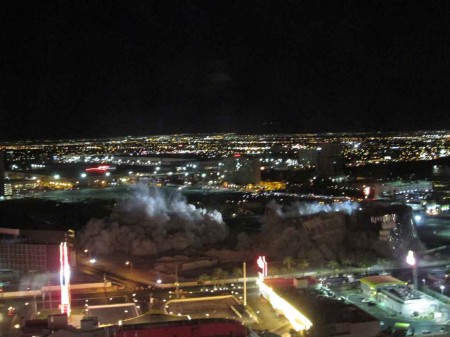As I reflect on my experience of this year, two dates stand out: June 14 and August 16. On those days, Riviera hotel and casino buildings exploded on the Las Vegas Strip, disappearing in seconds before the eyes of hordes of onlookers including me. All pales in comparison to those events crystallized ablaze in my mind as though my recollection were a looping cinematic projection. I still have trouble believing that it was real, so much it seemed like an orchestration of sophisticated tricks on a grander scale than any magician could accomplish.
Building implosions inevitably dazzle, but the periodic implosion-as-grandiose spectacle is a special Las Vegas phenomenon. From 1993-2015, 13 hotels were imploded.1 In Las Vegas, it simply isn’t proper for a casino to go down without a celebration, often involving auxiliary fanfare including but not limited to: lavish parties, live music, and astounding pyrotechnics.
The Riviera implosions were accompanied by far fewer auxiliary dramatics than some previous implosions. In 1993, for instance, the conflagrant implosion of the Dunes amid rings of fire incorporated a skit involving pirate ships at Treasure Island down the Strip. However, the dissolutions of the Riviera marked the end of an era of old Las Vegas Strip casinos. Enhancements were not needed in an already eerie pre-show beginning, an astonishing climax; and in the aftermath, a finale of lugubrious emptiness.
Having visited Vegas regularly during most of my life, I had not experienced an implosion live until this June. In casinos and museums, I had watched Las Vegas implosion video clips screened as pieces of recent local history, my awe of their splendor tempered with sadness derived from the disintegration of these edifices I knew as Vegas landmarks. Their onscreen explosions seemed like violent deaths. I remembered having regularly stayed at The Dunes and The Sands; their demolition videos were particularly poignant. The images remained in my mind, germs of a desire to see for myself.
***
***
Even before the Riviera was shuttered, whispers anticipated its implosion. Finally, the Las Vegas Convention and Visitors Authority (LVCVA), having acquired the property from Starwood in February 2015, decided late that summer to demolish it this year3 to make way for its own convention center expansion.
Some asked why the Riviera buildings couldn’t be modified or reused. As Brian O’Doherty stated in his recent essay “Las Vegas Revisited,” “If you break something in the United States, don’t try to fix it. Get a new one. “4 Many protested against destruction of the iconic buildings; but naturally Authority held the winning hand.
It decided to demolish the Riviera in two separate implosions. The first demolition, of the 24-story Monaco Tower, was said to be the one to see; it was tallest, and accompanying fanfare was expected to be more spectacular. To the masses including myself, this was all hearsay; little advance information was distributed by the LVCVA or reliable news outlets. Even the dates of each implosion were officially announced only a few days beforehand.
Therefore, vigilance was essential to would-be implosion goers. Checking news every day was advisable. Fortunately, a local blog called Vegasbright.com leaked the June 14 date early, enabling travelers to secure hotel reservations. Even then, one had to wait for authoritative confirmation of the leaked date. In each step of preparation, one had to be flexible and ready to alter plans.
The certainty that the buildings would be imploded was wrapped in a complex web of uncertainties. Exactly which buildings would be imploded? There were several, including parking garages. On what dates would each implosion take place? Even after the first implosion date had been confirmed, the second was up in the air. Literally until the last moments, the times of each implosion also remained in the air. Some reports said 2:00 AM; others said 2:30. Where to watch? Streets would be blocked off, but which ones? There were only a few areas where the entire buildings would be visible. How close would onlookers be allowed to get? No one knew, not even police on the scene of each implosion, until minutes beforehand.
***
June 13
Several horizontal black strips lined the gutted Monaco Tower the day before its immolation. We orbited the building in reconnaissance, seeking potential observation areas. Crews had been deployed to swathe nearby structures, including Somerset Gardens, an apartment complex so close to the Monaco Tower that residents were given the option of either staying in their rooms under temporary house arrest, or going to a hotel.
Uncertain of implosion time blockages, we needed at least one backup observation area. Our first was supposed to be an upper-story room at Circus Circus across the street from the Riviera. This proved an unsuitable vantage point: other buildings blocked the Monaco Tower; even higher floors yielded only partial views. Reconnoitering the surrounding area at street level disclosed the Peppermill Restaurant parking lot’s unobstructed view of the west side of the Monaco Tower, an ideal location.
June 14
About midnight, we were among the first pedestrian arrivals in the Peppermill lot. Only a few isolated groups milled about the dim lot full of parked cars whose absent owners were presumably partying inside the restaurant. A rotund Elvis impersonator in full regalia strutted about, demonstrating high esteem for himself and his vanity-plated sports car. In an out-of-the way expanse on the parking lot’s east side, tailgaters eked out territories and marked them with chairs and loud music. The police line was still mutable; deconstruction workers and policemen unsure of exactly where the yellow tape should go kept moving it periodically upon receipt of directions via radio.
The passage of minutes brought people in droves. Muffled strains of live music and microphone announcements occasionally wafted from the official celebration at the Gold Lot northwest of the northwest corner of Convention Center Drive and Paradise Road. To anyone who would listen, a crone seated in a camp chair boasted of witnessing other implosions, while her inebriated middle-aged son heckled demolition workers and tested authorities’ patience by periodically crossing police lines.
On the front lines, we had the best view, with only yellow tape, police and demolition workers, and chain link fences between the Riviera site and us. One hard-hatted deconstruction worker said there would be fireworks; another said there would be none. One said the implosion would take place at 2:00, another said 2:30.
We waited, waited, waited, checking time, contemplating the building. Anticipation diluted boredom. The Monaco Tower stood forlornly against the dark sky, its windows empty, desolate as though aware of imminent death. The scene was dismal, yet so exciting. People kept arriving. As they pressed closer in the warm air, I realized that a huge crowd had accreted behind us. A man stood on the Peppermill rooftop, camera in hand; others perched on cars. The collective atmosphere was festive and suspenseful like that of public gatherings for Independence Day, New Year’s, and solar eclipses; however, this crowd was united by disintegration; its tenor seemed more uncertain, more grave than usual strains of public excitement, the imminent event almost cataclysmic.
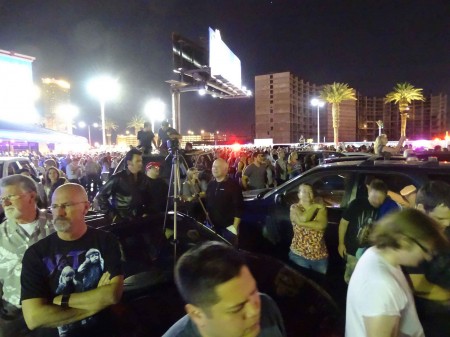
Nearing 2:30, restless chatter subsided into stillness. Minutes before implosion, demolition workers and police were not moving about; the cars on Las Vegas Boulevard were gone. An eerie silence was in the air.
Abruptly the silence ended; fountains of fireworks cascaded from the top of the Monaco Tower. The sky blazed with profuse pyrotechnics of a density rivaling that of any Independence Day finale I’ve ever seen; they seemed to go on endlessly–would the building implode underneath them? I kept my eyes on the target so as not to miss the key moment, but they continued and continued. Finally, the pyrotechnic dazzle ended. People started asking what happened, clamorously stating the obvious fact that the edifice was still there. A chant resounded louder and louder: “Blow it up! Blow it up!” The minute and a half pause that seemed to me like no time at all was finally broken by a pop beginning a countdown of individual fireworks in numerical shapes from ten to one, numbers echoed by the boisterous crowd. After “1” exploded, a final fountain shot from the rooftop. Breaths were bated, eyes on the Monaco Tower.
Suddenly, impetuous sparks of white light cracked deep inside the high-rise, blinding, popping, coruscating, reverberating, too quick and too numerous to apprehend all individually, visible inside empty windows, many simultaneous, as though hundreds of flares flickered rapidly on and off inside the hollow tower’s rooms in upper and lower floors, forming horizontal flash-lines, prevailing movement bottom to top, as though lower story lights were going on almost all at once, instantly succeeded by upper floors; flashes were far too bright to be from lamps; it was more like a light show and suddenly the pre-implosion pyrotechnics seemed a garish caricature as these explosions became seismic, accelerating in resonant waves, their collective drum-roll rumble aggrandizing to a tremendous cumulative roar that felt like being next to railroad tracks as a freight train passed; the earth shook, air trembled, all quake and thunder, as though the sparks were lightning bolts burrowing into the earth; deafening, burrowing into the core of my body and shaking me; one of my hands involuntarily covered my ear while the other holding my camera trembled violently as though strung to the shaking earth.
The edifice’s middle sagged; its total form crumbled and precipitated into smoke nearly instantly, like a silk sheet falling to reveal some marvel, only this fall itself was the jaw-dropping marvel. The crowd erupted, clapping, carousing, exultantly shouting as though in effort to match the preceding explosions’ roars.
In America, not only do we get new things instead of fixing the old, we celebrate the destruction of the old without knowing what is to come. It felt like New Year’s Eve: out with the old, in with the new; only here the only thing to celebrate was the destruction of the old, nothing new would replace it anytime soon, and who was to say that once it was built, the new venue would be as good, or an improvement? The Stardust was imploded in 2007, and there is still nothing in its place but a deserted construction site.
Why did people celebrate? Surely in part, their cries of excitement were not for the destruction itself, but for the spectacle they were witnessing, a sort of Burkean sublime horror. Though I saw no reason for merriment, I, too, felt a sense of exhilaration. It was almost frightening, like a roller coaster. Moreover, there were still the remaining implosions in August to look forward to, which overwhelmed the sense of finality. After all, this was only one of the Riviera’s buildings; several remained, including the beautiful mirrored cylindrical facade now quickly being enshrouded in mist glowing with sundry colors from artificial lights.
I was dizzy, still shaking, staring awestruck at the implosion site with everyone else. As the hordes celebrated, a cloud of smoke and debris mustered energy, towering over the implosion site; and then lurched towards us like a pyroclastic flow, menace dampening merrymaking. “Run!” someone shouted, with more jocularity than fear. Barely twenty yards away, the billowy mass engulfed a policeman and his squad car; but changing wind direction spared us.
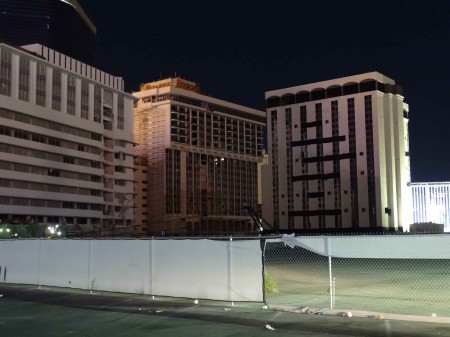
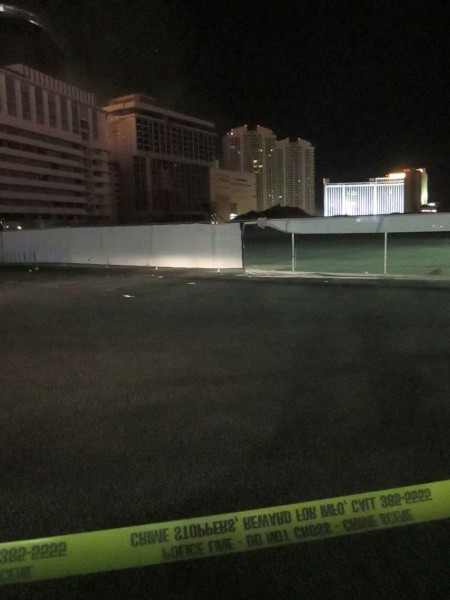
As smoke diffused, a mountain of rubble came into view. People dispersed, their gradual exodus manifesting a lot littered with legions of empty bottles and bags, testament to revelry.
On Las Vegas Boulevard, a thick layer of gray dust covered the road, sidewalks, rocks, plants, newspaper stands, like dirty snowfall. Shoes left footprints in the accumulation. Buoyant particulate matter made my eyes water and burn. I was glad to have brought a dust mask, despite the fact that wearing it subjected me to ridicule by barefaced passersby in the toxic fog.
The mess was meant to be cleaned up as quickly as the building had disintegrated; it was imperative that Las Vegas glamour be swiftly restored to the main drag. As pedestrians set foot on the street still closed to auto traffic, huge vehicles like snowplows lumbered back and forth, spraying the road with water. The grime wasn’t washed away so easily. Air, sidewalks, and everything else except the road remained dirty.
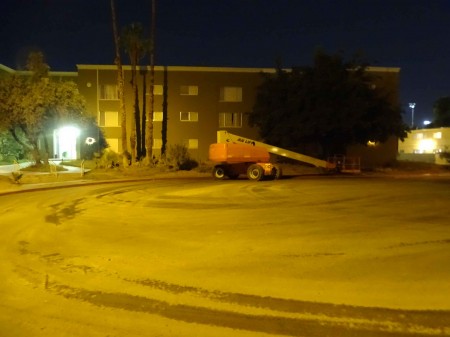
Behind the implosion site, Somerset Gardens looked like a disaster zone. The ground was gray and irregular like the surface of the moon. Draping cloths had offered its structures modest protection from the onslaught of debris and dirt. Under dull orange lamplight, cleanup crews plopped bag after bag of detritus onto a prodigious pile that became more and more mountainous every minute. By 4 AM, they still had much work to do. The most marvelous spectacles have dismal sides.
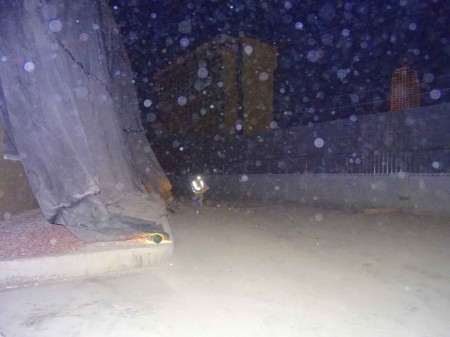
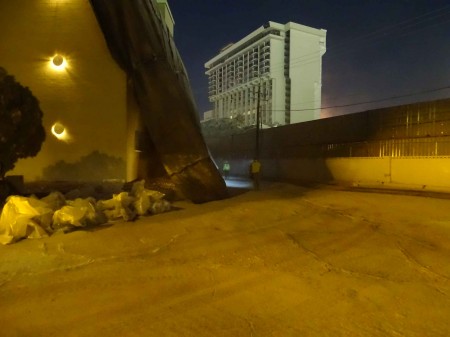
I revisited Somerset Gardens the following afternoon. The parking lot was still thinly coated in tiny particles of the Riviera whose wreckage loomed monstrously over the wall separating implosion site from apartment complex. Scenes of ruins abuzz with workers and clanging machinery were visible through decorative holes in the wall. Dust now painted white by sunlight eddied in a breeze. I felt as though I were searching for meaning that eluded me, trying to find significance in that which had been imploded. All I knew was that I needed to see the next implosion.
***
August 15
The total experience of observing a building implosion, from searching for a vantage point to finally witnessing the aftermath, unmasks the singularity of one’s perspective and unfolds nuances of the cityscape and one’s individual relationship to it, for perspective is everything.
Two buildings were set to implode, and it was difficult to find a sightline encompassing both in their entirety. Once again, the Peppermill parking lot promised an ideal view at street view; the facade was even closer than the Monaco Tower had been. Unlike last time, our Circus Circus room also afforded an excellent view.
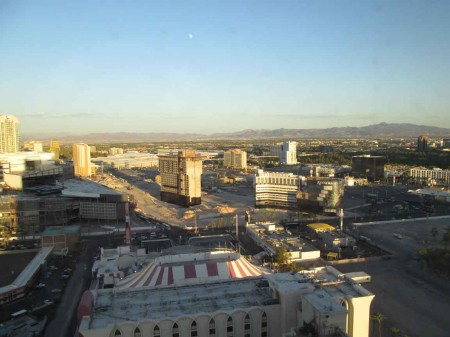
Late afternoon, I sat before the window, gazing down at the demolition site below. In the deepening blue sky, a waxing gibbous moon hovered directly over the apex of the tallest tower. Most of the debris from the Monaco Tower and other demolished structures had been hauled away. Our Circus Circus high-rise shaded a large oblique swath of terrain, avoiding the Riviera site and contrasting with its remaining gold-bathed buildings surrounded by glowing pink bulldozed dunes. The tallest remaining structure, the Monte Carlo Tower, cast its last shadow angled far away on the developed desert floor, its apogee reaching towards distant mauve mountains. The 17-story tower had become a sundial marking the end of its own time. Its umbra inched slowly, asserting itself once more over its neighboring buildings. Salmon and lavender played on the desert floor, changing hue imperceptibly with every moment as the tower’s shadow extended further and further before retreating. As salmon-gold dimmed into rosy gray, the umbra faded into obscurity.
For me, the cylindrical silver facade was synonymous with the Riviera. Neon shapes had been assembled into a fanciful picture on its surface that in totality functioned as a sign. For some reason, I had always thought the cylinder an actual building. It was only looking down on it now that I realized that it was only veneer, completely hollow; and viewed from above, it was more elliptical than cylindrical. As dusk took hold, I imagined the Riviera lit up, its multicolored neon rings bouncing back and forth around its street entrance; facade resplendent with the gaseous glory of whimsical foliage, five-pointed stars, long-gone stylized neon swimmer that once perpetually dove in advertisement for its “Splash” show. In reality, much neon had been removed; now only stars and smaller ornaments remained. They were not lit; yet the lights of nearby buildings sparkled, and the mirrored surface glittered by proxy.
August 16
Few were in the Peppermill lot when we arrived shortly after midnight. No police lines were in place, and people were talking of the restaurant closing shortly, which was a bad sign; it hadn’t closed for the previous implosion, except during the event itself. Furthermore, it seemed either too good or too risky to be true, that we’d be allowed to get this close. A few minutes after we arrived, policemen drove by, told us that the lot would be closed; every area in the vicinity would be closed; the closest observation area would be the intersection of Las Vegas Boulevard and Convention Center Drive. We retreated to the sidewalk of that intersection and found the view obstructed by light poles in the parking lot we had just left. A man wheeled by on a bike, claiming to have been born inside the Riviera, and informed us that the Travelodge was allowing people to congregate in its lot. The view there was worse, obstructed not only by light poles, but also by buildings. Giving up on ground level, we returned to Circus Circus.
Cloistered high above the energetic street, time seemed to pass especially slowly; but the aerial perspective was more encompassing, affording panoramic glimpses into scenes going on simultaneously in different places. From the bird’s eye window view, we watched groups accrete at the Travelodge and on Convention Center Drive at Las Vegas Boulevard. Swift red lights attached to otherwise invisible drones hovered and maneuvered. Police blocked off streets. Isolated groups slowly morphed into consequential crowds.
About 2:15, eerie stillness set in; movement stopped. The streets were utterly empty.
A multi-beam rotating spotlight signaled impending implosion. I stood tense before the window, my camera lens on the glass. I must have taken a hundred photos of the target buildings, not wanting to miss the implosion moment. It didn’t come; I checked the time and waited more…I checked again and it was nearly 2:30. Distance and insulation dulled sensitivity to audiovisual portent; I hoped for a countdown. There would be none. Ironically, the Monaco Tower was the newest building, and it was the only one appointed with fanfare. Or perhaps this was not so ironic; maybe the newest building’s destruction best symbolized the hotel’s total erasure.
Intense orange bursts jarred me out of complacence. Windows rattled; floor shook. Even muffled, the rumbling was hellish. Fiery explosions permeated both structures in successions of percussive trauma. The mirrored facade glittered brilliantly as it fractured and slumped into gray smoke. No sooner had it started than it was over.
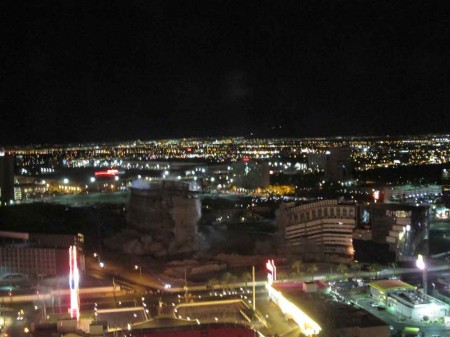
Billowing debris mushroomed and rolled like a low storm cloud, enfolding Circus Circus lights and glowing igneous red, umber, and pink like vaporized cotton candy. Phantasmal faces formed and mutated like temporary smoke-sculptures in the buoyant aggregate. As it gained momentum, the roiling mass sent pyroclastic flow-like shoots into the streets. One of these crept onto Las Vegas Boulevard, another into a Circus Circus alley; still another lurched into Circus Circus Drive and hurled straight for the Travelodge. Crowds scattered; some ran in panic. Those unable to outmaneuver the debris cloud were powdered gray. There were benefits to watching from indoors, after all.
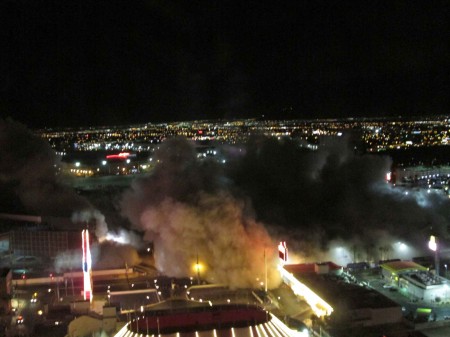
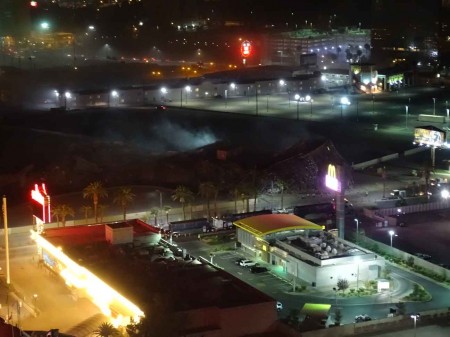
As vapor cleared, ominous black heaps came into view, giant mutilated corpses where buildings once stood. Isolated flames burned inside wreckage near the street. Workmen sprayed hoses on smoldering rubble. It took nearly 20 minutes for the debris to settle; then we returned to the street.
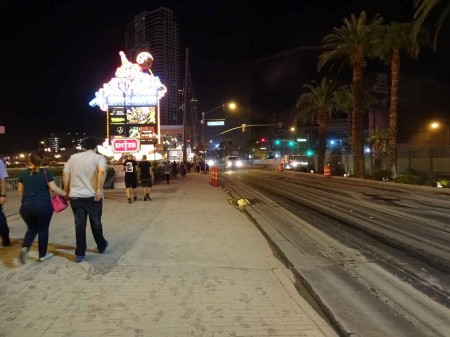
Las Vegas Boulevard and its sidewalks were covered in a thicker layer of dust than from the previous implosion; this was from more buildings, closer to the street. Having already seen an implosion, I had not been so overwhelmed by this one. However, this aftermath was as awe-inspiring as the implosions themselves. The scene was far bleaker, partly by virtue of the fact that it was so close. The facade had disintegrated into a colossal mound spilling onto sidewalk and asphalt. Stars and diamonds remained attached to shattered pieces of facade glass.
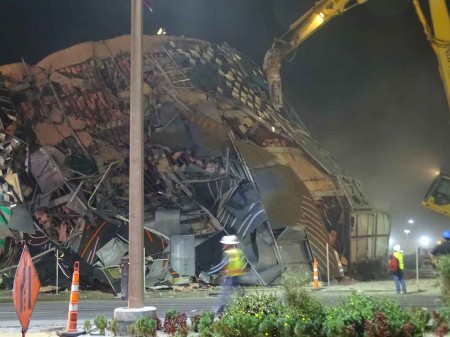
Machines were already removing debris. Like prehistoric beasts chewing on a dead dinosaur, they chipped away with beaklike precision at the great glassy hulk. Metallic shrieks filled the air, grating and grinding like thousands of fingernails on chalkboards. Vehicles dedicated to the restoration of cachet impartially sprayed street and pedestrians alike. Many were stopping on the sidewalk, taking photos or just staring awestruck, and a motorcycle policeman barked at us all to keep moving. Industrial creaking and grumbling overwhelmed his voice, and he flashed his lights threateningly. Every time anyone paused for more than a few seconds, he barked more, yelling not to stop. However, he couldn’t control the speed at which one strolled, and where their eyes or cameras were directed as they walked. Finally, he gave up.
August 17
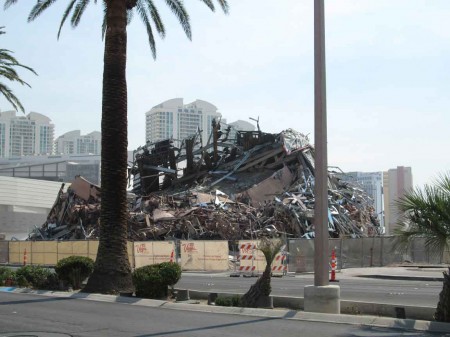
The day after implosion, the wrecked hulk shimmered in morning sun, gorgeous even in its grotesque decomposition. Gazing at it from the sidewalk across the street, it struck me that its form reminded me of Frank Gehry’s Cleveland Clinic Lou Ruvo Center for Brain Health about three miles away, only this building was truly in a state of deconstruction. Ironically, the Gehry building, dedicated to Alzheimer’s disease, is associated with a nonprofit called “Keep Memory Alive,” whereas this represented the death of an icon itself, and along with it at least part of its memory.
At last I found the meaning I had been searching for. Here the colossal wreckage was a symbol of the evanescence of money and resources. The scintillating shards proclaimed the fact that dreams are shattered more easily than built, that wealth can evaporate as quickly as it pools.
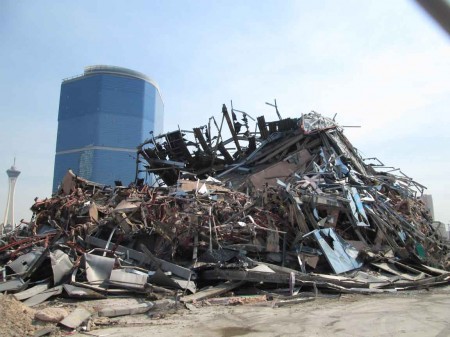
Everyone hustles in casinos: gamblers, dealers, cocktail waitresses, lights and sounds. Carpet quickly wears thin. Visitors stay for a few days, then leave. Hotels are made for transients; so are convention centers. People come and go, so does money. Shows disappear, so do buildings. An aptly temporary monument to change, the mountain of Riviera remains would soon be hauled away.
For now, it lay glimmering, a mirage paradigmatic of the artificiality of this desert metropolis. Stars and jagged mirrored strips jutted from the steel fantasia as though from a giant futuristic gewgaw. The scene was so perfect in its deconstruction, straight out of cinematic fantasy, like a movie set.
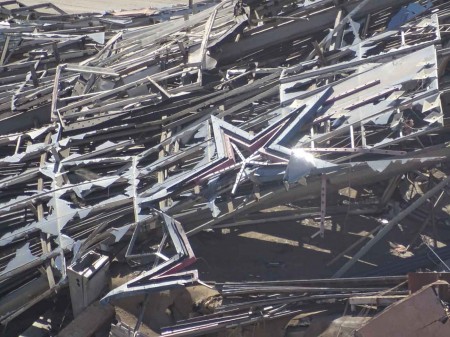
Demolition via implosion is a feat of factitiousness. It involves art, science, and entertainment. As Mark Loizeaux, president of Controlled Demolitions Inc., a company behind several Vegas implosions said, “It’s almost like structural origami. We take structures and we fold them in a fashion to make them collapse on themselves.”5A building that took months, years to complete comes down in seconds in a relatively neat pile. Demolition consultant Herb Duane calls implosions “the greatest free show on earth.”6In Las Vegas, the artificiality of the building’s destruction (and by extension its existence in the first place, especially as Las Vegas buildings are showy, proclaiming liveliness with shiny glass and ostentatious signs) is underscored by fanfare and celebration.
An implosion’s ideological significance is derived from iconic ruin. Destruction and documentation thereof becomes a sort of anti-monument, a tribute to ruination as a harbinger of newness and the flowing current of change. Long after the building is gone, accounts and videos of its implosion perdure as monuments, spoken of, shown as pieces of history. Thus, the iconic places are memorialized through their demolition even for those to whom they mean nothing otherwise. Perhaps here, Baudrillard’s notion of hyperreality meets its ultimate sublimation.
Cheers for the previous implosion still rang in my ears. Perhaps some reveled because they sensed they were taking part in, or at least witnessing, something historic. Acts of demolition can be as meaningful as acts of fabrication. It’s a simple formula: destroy the historical to make history; derive significance from ruin. Sometimes we value consequence for its own sake.
***
Back in the room, looking out the window, gaps made it appear as though the skyline had lost several teeth. No matter, the Strip is a polyphyodont. From this perspective, it was plainer than ever why the Riviera had to go. Towering, glimmering new skyscrapers, dwarfing everything including this Circus Circus high rise, speak to the fact that Las Vegas’ skyline is more aspirational than ever.
Yet looking at the desolate site, I felt a sense of emptiness deeper than I had with the previous implosion, not to mention the videos I watched before having seen one live.
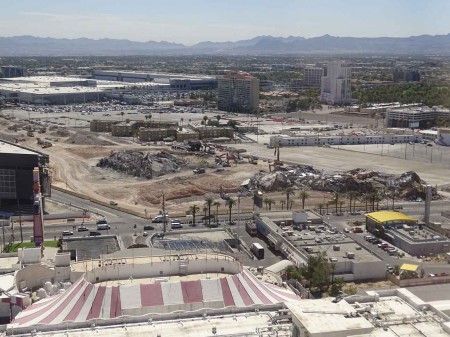
I imagined Circus Circus imploding, windows rattling, the building crashing down. Yesterday the Riviera was there; today it was gone. Likewise, the building in which I stood would likely traumatically fall one day. Far below Circus Circus, people walked around, tiny and undistinguished like ants rushing back and forth. Yesterday, all eyes were on the Riviera; today it was hardly paid a second glance. There were other things to do. And I had a suitcase to pack, a room to vacate by 11:00.
-Annabel Osberg
1 http://www.vegastodayandtomorrow.com/implode.htm; https://www.yahoo.com/news/las-vegas-implosion-takes-down-off-strip-clarion-114044254.html?ref=gs
2 http://www.a2zlasvegas.com/hotels/history/h-riviera.html
3 http://vegasinc.com/business/2015/aug/11/tourism-board-approves-42-million-riviera-demoliti/
4 Brian O’Doherty, “Las Vegas Revisited,” Art in America, December 2016, pp. 96-105.
5 http://www.casinolifemagazine.com/news/las-vegas-%E2%80%98-implosions-capital-world%E2%80%99
6 Ibid.
![riviera-dusk[1]](https://aeqai.org/wp-content/uploads/2016/12/riviera-dusk1-450x337.jpg)
